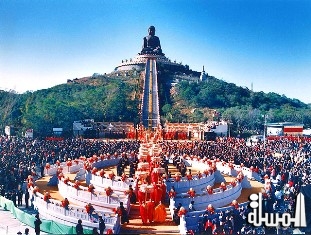
PolyU Study finds tourists resilient to Hong Kong weather
aTP- Arab tourism portal News- HONGKONG, — Tourists are quite resilient and rarely change their plans when they encounter poor weather while visiting Hong Kong, according to Professor Bob McKercher of the School of Hotel and Tourism Management (SHTM) at The Hong Kong Polytechnic University and his co-researchers.
In a recently published study, the researchers tracked visitors’ movements for almost two months to see whether the weather caused any changes in their behaviour.

They found that unlike tourists to non-urban destinations, Hong Kong visitors tend to continue with their plans regardless, although “perceived comfort levels” do affect satisfaction for a small number of visitors.
Although it is generally accepted that weather affects tourists’ behaviour, there is actually surprisingly little evidence for this relationship. The researchers explain that in bad weather, tourists have few options other than cancelling or postponing activities, substituting less weather-sensitive ones, shortening their stay or simply enduring the weather conditions.
One difficulty in assessing the relationship between weather and behaviour, the researchers write, is that people may perceive the weather in quite different ways. Tourists’ perceptions, for example, may vary “depending on how similar or dissimilar the weather is to that encountered at home”, their “expectations of weather at the destination” and how easily they adjust to the “abrupt changes in temperature and humidity” they may experience while travelling.
Yet the researchers note that very little attention has been paid to how perceptions of weather, rather than the weather itself, affect tourist behaviour. Furthermore, the focus is usually on non-urban destinations, where people may stay longer and have more flexibility in substituting or delaying their plans.

The researchers were thus interested in finding out how the weather affects tourists visiting Hong Kong, an urban destination with a subtropical climate that can produce extreme weather conditions such as prolonged high temperatures and humidity, heavy rainfall and typhoons, which might be expected to influence people’s choice of activities.
Hong Kong also has a “significant air pollution problem”, they explain, due to local traffic and power plants and cross-border pollution sources, which could also affect tourist activities.
To find out how these conditions affected tourists’ behaviour and satisfaction while visiting Hong Kong, the researchers approached guests staying at a hotel in Hong Kong’s centrally located Kowloon district.
They conducted their investigation over a 57-day period in summer, asking the tourists about their visits, their intended activities, whether they had checked the weather forecast and whether it had affected their plans. They also asked the tourists about their perceptions of the weather, how comfortable they found it and how similar it was to the weather they experienced at home.
Each tourist was then given a GPS tracker that allowed the researchers to track their movements throughout the rest of the day.
The majority of those who took part were from non-Asian markets, with the largest proportions from Europe and Oceania. Most of the tourists were travelling with only one other adult, and less than a quarter were travelling with children. Many were visiting Hong Kong for the first time, and the average trip length was four nights.
During the period under investigation, Hong Kong experienced rain on 30 days, with the heaviest rainfall of 112 cm in one 24-hour period. Thunderstorm warnings were issued on 22 days, hot weather warnings on 23 days and typhoon warnings on two days, once for a severe typhoon.
The researchers found that more than half of the tourists considered the weather in Hong Kong to be uncomfortable, mainly due to rain, humidity and a combination of heat, humidity and pollution.

Around 60% of them said that they had checked the weather forecast before leaving the hotel. However, only about a quarter changed their plans, usually on days with heavy rain or hot unsettled weather.
To find out which places the tourists visited, the researchers divided Hong Kong into 25 areas, each representing a single thematic location, major tourist node or popular shopping district. Using the GPS data, they were able to track which areas visited.
They were then able to compare the areas visited with the actual weather conditions and the tourists’ perceptions (e.g., whether they found it comfortable) of the weather conditions on those days.
The researchers comment that the study participants were “very active regardless of the weather conditions encountered”. They spent an average of seven hours outside the hotel, during which time they generally visited or passed through about eight of the mapped areas. Overall, the weather had little effect on the likelihood of the tourists visiting particular places.
However, the researchers did find that the amount of time spent in some areas varied with particular types of weather. For instance, the tourists spent less time at the Hong Kong Island piers and on Victoria Harbour in bad weather such as when it rained or when a thunderstorm warning was issued, but spent longer in these places on bright sunny days.
Conversely, on rainy and stormy days tourists spent more time in Tsim Sha Tsui South, and on hot and sunny days they spent less time at the Citygate Shopping Centre.
The level of pollution, in contrast to the weather, had quite noticeable effects on the amount of time the tourists spent at particular locations. For instance, on days with high pollution, they spent less time at the Peak area and in Kowloon. On these days, they were more likely to spend time indoors, usually at shopping centres.
Although the weather may have had little effect on what the tourists chose to do, it did seem to affect how satisfied they were with the destination. However, the researchers note that differences in satisfaction were more related to tourists’ perceptions of the weather rather than the actual weather they encountered.
When asked to explain how the weather affected their satisfaction, the tourists were most likely to mention heat, followed by air quality, rain and humidity. They commented that “sometimes our children wilted in the heat so we had to detour into air conditioning” and “I would prefer less smog to make it easier to breathe”.
Nevertheless, the researchers suggest that overall, “most people adopted a philosophical attitude” toward the weather.
The researchers caution that it is also important to recognise that other factors, apart from the weather, can affect tourist behaviour. They found that families with children, for instance, visited fewer places but spent more time in them than visitors without children. They were most likely to visit theme parks, and “less likely to visit the Peak, the Avenue of Stars and major street markets”.
The researchers conclude that “tourists are highly adaptable” and regardless of what the weather brings, they “want to make the most of the significant time, financial and emotional investment” in visiting a long-haul destination such as Hong Kong.
Rather than change plans, they adapt by protecting themselves from the sun and rain, making “frequent forays into air-conditioned buildings” and moving more slowly than usual.
Nevertheless, the weather does affect visitors’ satisfaction, so the researchers suggest that tourism industry practitioners should be aware of this when advising tourists on where to visit and what activities to pursue in a destination to “enhance the opportunity for a satisfying experience”.
McKercher, Bob, Shoval, Noam, Park, Eerang and Jahani, Alon. (2015). The [Limited] Impact of Weather on Tourist Behaviour in an Urban Destination. Journal of Travel Research, 54(4), 442-455.








